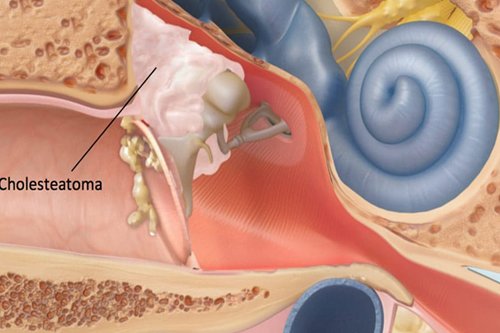Brain and ENT Clinic – Dr Lalit Mahajan In Nagpur & Dr Rachna Gangwani Mahajan In Nagpur
Cholesteatoma

Symptoms of Cholesteatoma
Ear Pain or Discomfort: Persistent or recurrent pain in the affected ear.
Hearing Loss: Gradual hearing loss is a common symptom, especially if the cholesteatoma affects the delicate bones of the middle ear.
Ear Discharge: Foul-smelling discharge from the ear, which may be persistent or recurrent. The discharge may contain pus or other materials.
Tinnitus: Ringing, buzzing, or other noises in the affected ear.
Vertigo or Dizziness: Cholesteatoma can sometimes affect the inner ear, leading to balance issues and vertigo.
Fullness or Pressure in the Ear: Some individuals may experience a sensation of fullness or pressure in the affected ear.
Facial Muscle Weakness (Rare): In advanced cases, cholesteatoma can erode nearby structures, including the facial nerve, leading to facial muscle weakness.
Treatment Of Cholesteatoma
- Tympanoplasty:
- Description: Tympanoplasty is a surgical procedure to repair a perforated eardrum. It is often combined with cholesteatoma removal.
- Purpose: To close the perforation and remove any cholesteatoma from the middle ear.
- Procedure: The surgeon grafts a small piece of tissue onto the eardrum to repair the perforation. If cholesteatoma is present, it is carefully removed during the surgery.
- Mastoidectomy:
- Description: Mastoidectomy involves the removal of the mastoid air cells, the bony area located behind the ear. It is often performed in cases where cholesteatoma has extended into the mastoid bone.
- Purpose: To fully remove the cholesteatoma and infected tissue to prevent recurrence and complications.
- Procedure: The surgeon removes the cholesteatoma and infected tissue from the middle ear and mastoid bone.
- Ossiculoplasty:
- Description: Ossiculoplasty is a procedure to reconstruct or repair the small bones (ossicles) in the middle ear that may be damaged by the cholesteatoma.
- Purpose: To restore hearing function by reconstructing the damaged middle ear structures.
- Procedure: The surgeon may use prosthetic devices or grafts to reconstruct the ossicles.
- Medication: Antibiotics may be prescribed postoperatively to prevent or treat infection.
- Hearing Rehabilitation: If hearing loss occurs, hearing aids may be recommended to improve hearing function.
